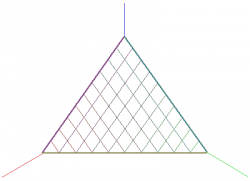Flux
At any give point along a curve, there is a natural vector, namely the (unit) tangent vector $\TT$. Therefore, it is natural to add up the tangential component of a given vector field along a curve. When the vector field represents force, this integral represents the work done by the force along the curve. But there is no natural tangential direction at a point on a surface, or rather there are too many of them. The natural vector at a point on a surface is the (unit) normal vector $\nn$, so on a surface it is natural to add up the normal component of a given vector field; this integral is known as the flux of the vector field through the surface.
We already know that the vector surface element is given by \begin{equation} d\SS = d\rr_1 \times d\rr_2 \end{equation} Since $d\rr_1$ and $d\rr_2$ are both tangent to the surface, $d\SS$ is perpendicular to the surface, and is therefore often written \begin{equation} d\SS = \nn \,\dS \end{equation} Putting this all together, the flux of a vector field $\FF$ through the surface is given by \begin{equation} \hbox{flux of $\FF$ through $S$} = \Sint \FF\cdot d\SS \end{equation}
We first consider a problem typical of those in calculus textbooks, namely finding the flux of the vector field $\FF=z\,\zhat$ up through the part of the plane $x+y+z=1$ lying in the first octant, as shown in Figure 1. We begin with the infinitesimal vector displacement in rectangular coordinates in 3 dimensions, namely \begin{equation} d\rr = dx\,\xhat + dy\,\yhat + dz\,\zhat \end{equation} A natural choice of curves in this surface is given by setting $y$ or $x$ constant, so that $dy=0$ or $dx=0$, respectively. We thus obtain \begin{eqnarray} d\rr_1 &=& dx\,\xhat + dz\,\zhat = (\xhat-\zhat)\,dx \\ d\rr_2 &=& dy\,\yhat + dz\,\zhat = (\yhat-\zhat)\,dy \end{eqnarray} where we have used what we know (the equation of the plane) to determine each expression in terms of a single parameter. The surface element is thus \begin{equation} d\SS = d\rr_1\times d\rr_2 = (\xhat+\yhat+\zhat)\,dx\,dy \label{triangle} \end{equation} and the flux becomes 1) \begin{equation} \Sint \FF\cdot d\SS = \Sint z \>dx\,dy = \int_0^1 \int_0^{1-y} (1-x-y) \,dx\,dy =\frac16 \end{equation} The limits were chosen by visualizing the projection of the surface into the $xy$-plane, which is a triangle bounded by the $x$-axis, the $y$-axis, and the line whose equation is $x+y=1$. Note that this latter equation is obtained from the equation of the surface by using what we know, namely that $z=0$.
Just as for line integrals, there is a rule of thumb which tells you when to stop using what you know to compute surface integrals: Don't start integrating until the integral is expressed in terms of two parameters, and the limits in terms of those parameters have been determined. Surfaces are two-dimensional!
